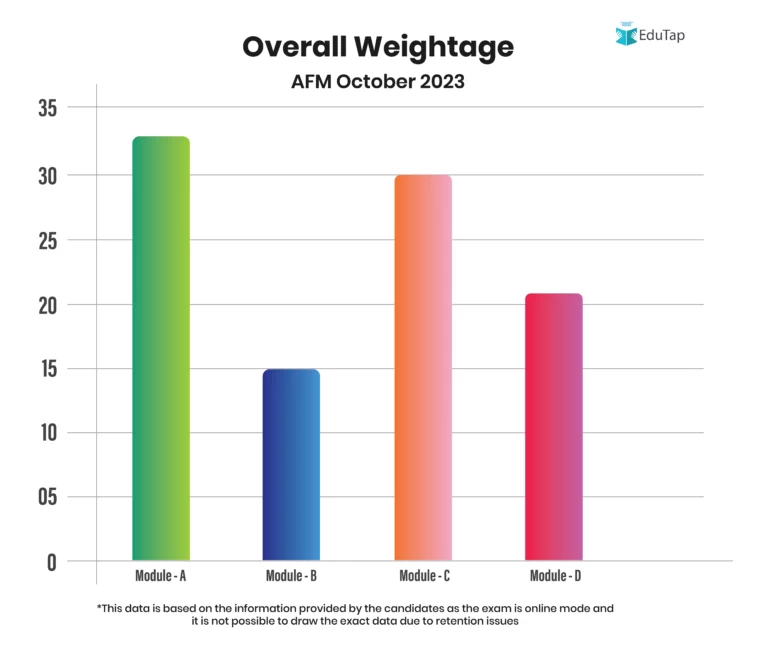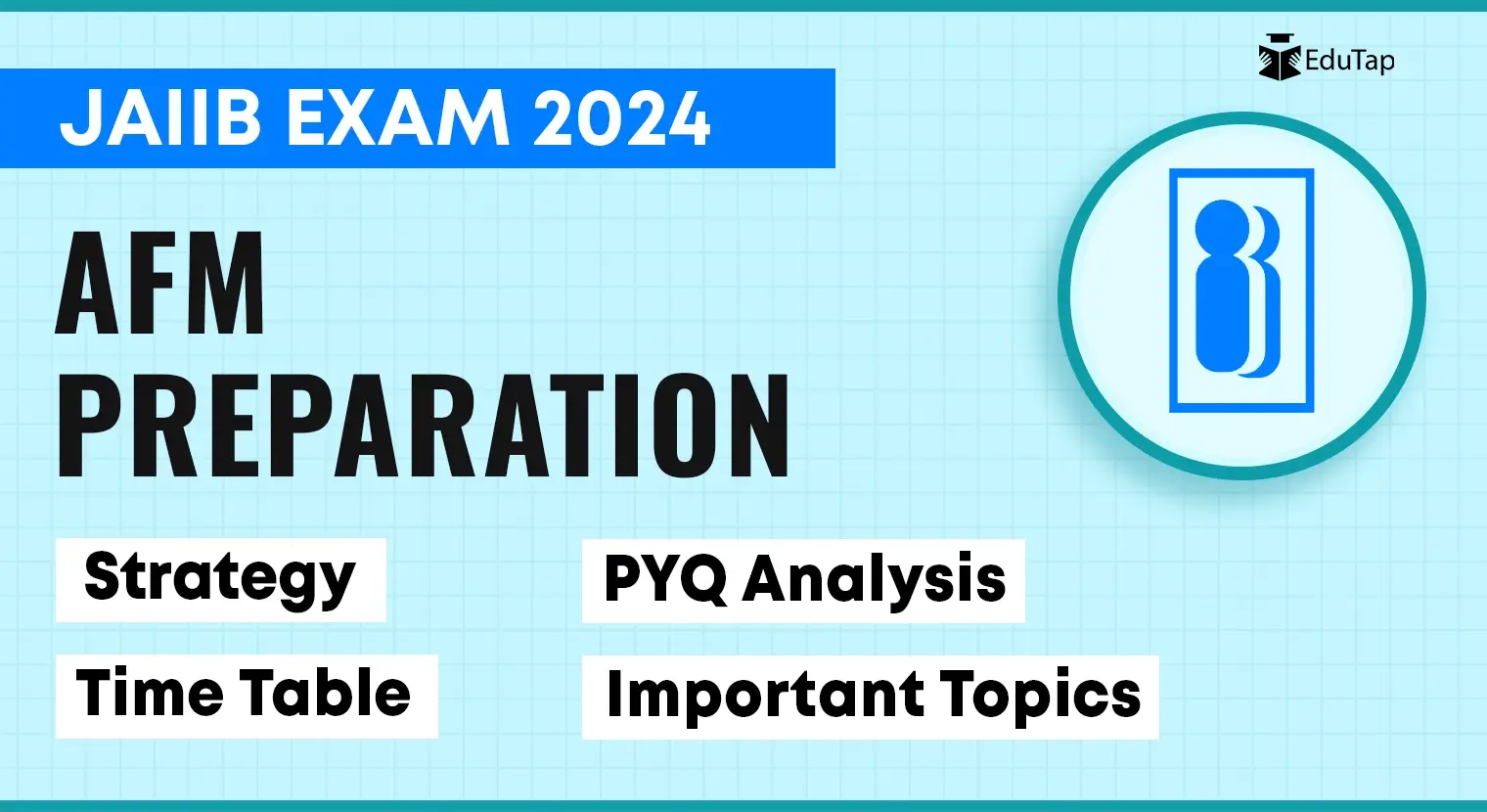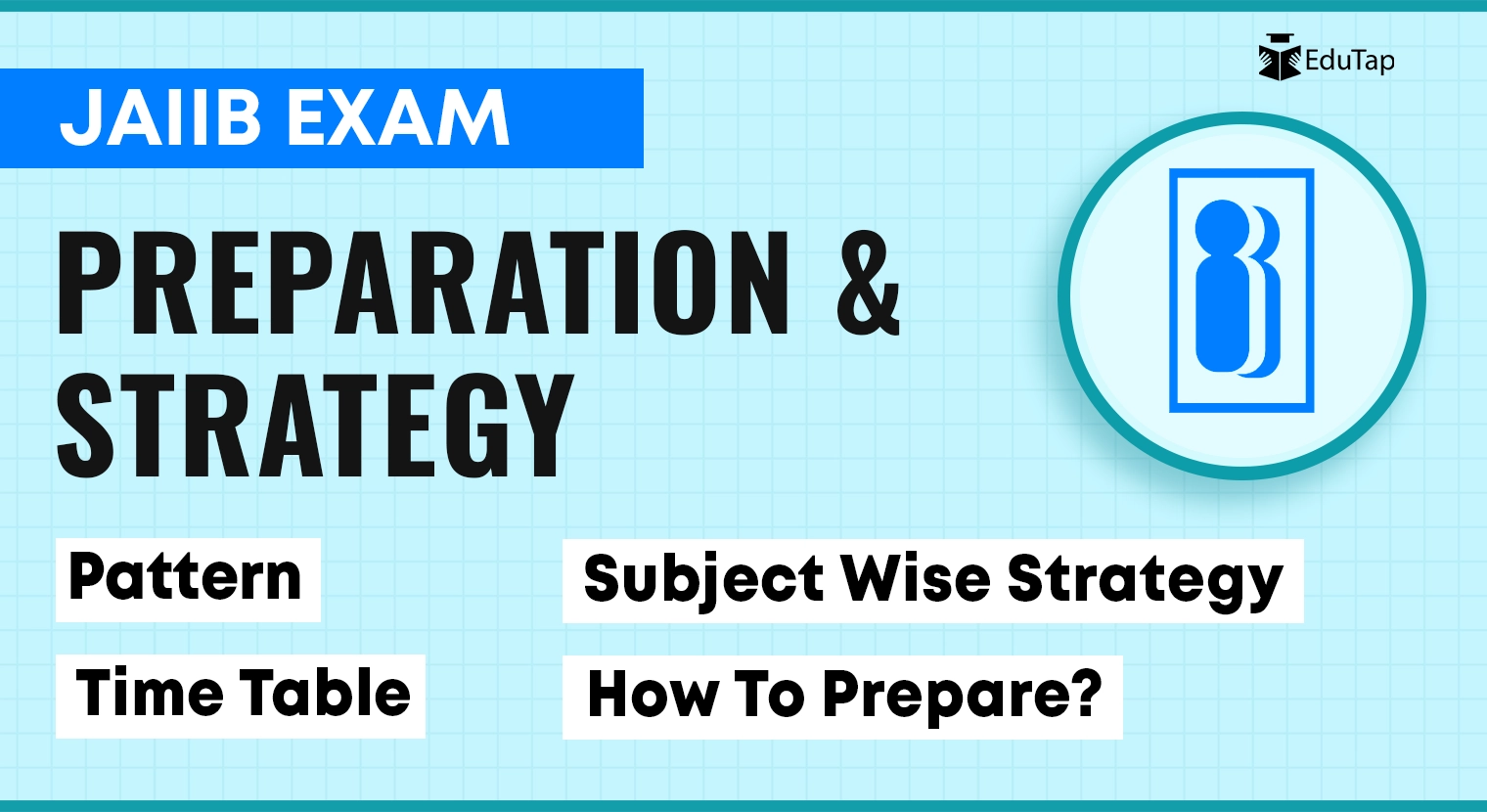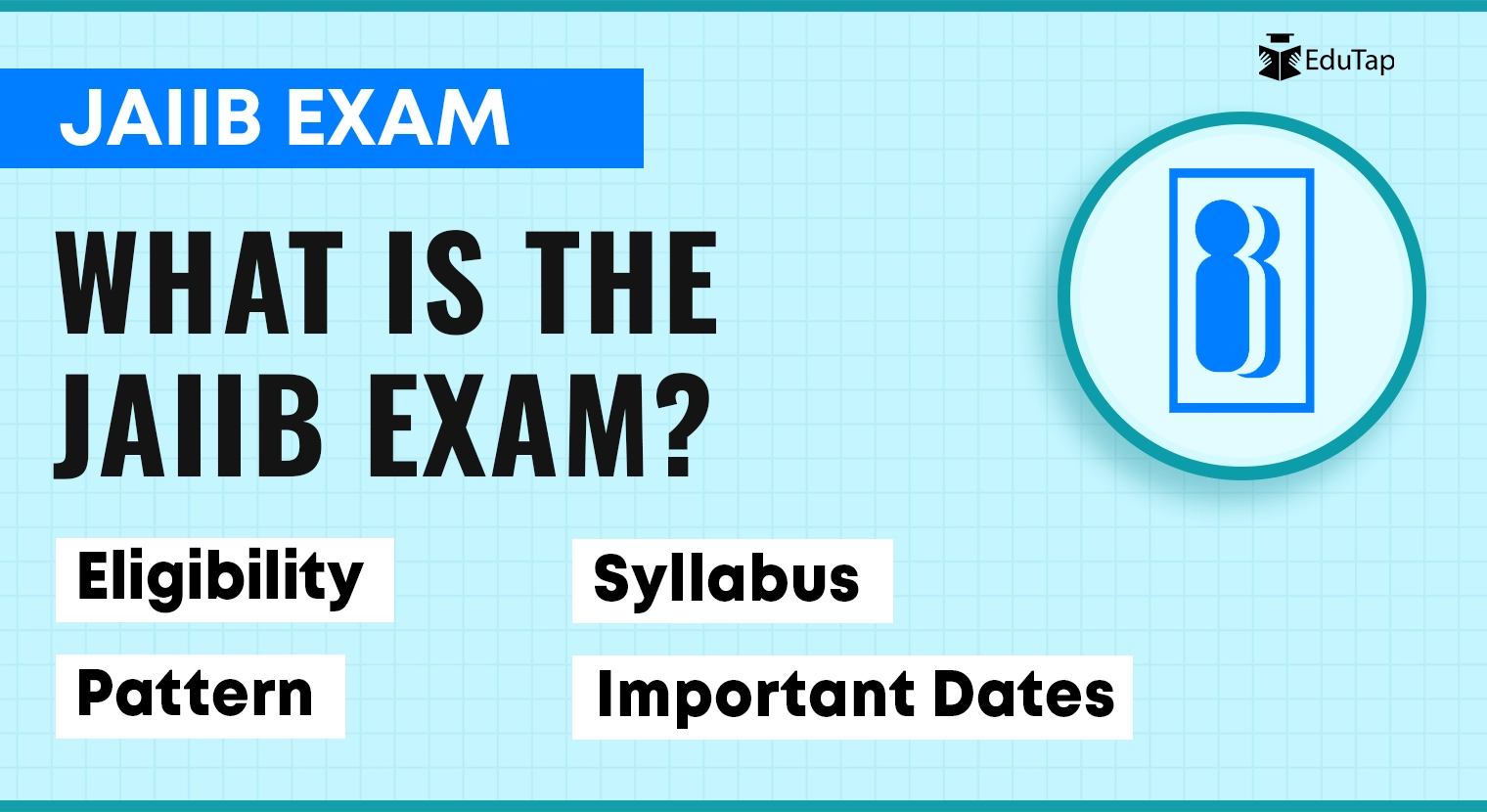Dreaming of qualifying the JAIIB exam but fearing your lack of accounting and financial management (AFM) expertise holds you back? You’re not alone! Many JAIIB aspirants like you feel scared by the prospect of understanding accounting and financial management jargon.
But fear not, this article is your roadmap to qualify the AFM paper, whether it’s your first attempt or second. In this article, we’ll break down the JAIIB AFM preparation strategy into 7 easy-to-follow steps, helping you identify the important topics, the best books and resources, how to cover each module, and which module to start first. Additionally, here you’ll also find a practical timetable that you can tailor according to your needs, enabling you to prepare well and qualify the AFM paper.
Step 1: Streamline the Syllabus
Before streamlining the syllabus, it is important to understand the complete syllabus of the AFM paper. AFM consists of four modules:
- Module A: Accounting Principles and Processes
- Module B: Financial Statement and Core Banking Systems
- Module C: Financial Management
- Module D: Taxation and Fundamental of Costing
Read the article “JAIIB Exam Syllabus” to understand the syllabus in detail.
Don’t be fooled by the vast JAIIB AFM syllabus – remember, your goal is to qualify, not achieve perfection! As a result, you must streamline the syllabus as you are not required to score 100% marks. It can overwhelm and distract you from your true goal, i.e., securing 50+ marks.
Moreover, by streamlining the syllabus you can identify the high-scoring topics, and prioritize your study plan effectively. This smart approach cuts down your workload, frees up valuable time, and keeps you laser-focused on the concepts that will truly help you qualify the AFM paper.
Now that you have streamlined the syllabus, it is time to analyze the PYQs to understand the difficulty level, AFM trends, weightage, and question types.
Step 2: Understand the PYQ Analysis
PYQ analysis reveals which topics appear regularly in the paper, their weightage, and question types, allowing you to prioritize your study efforts and focus on areas with high weightage.
To make it easy for you, we have analysed the AFM May and October 2023 papers to identify the key takeaways. Read below:
1. Difficulty Level
The overall difficulty level of the JAIIB AFM paper in October 2023 was moderate to difficult and lengthy. It took a lot of time to read the questions. As a result, effective time management becomes crucial to successfully tackle the statement-based long questions.
2. AFM Trends
Among all the modules, Module A witnessed the majority of questions, closely followed by Module C. Module D featured some numerical questions and Module B had the least number of questions.
Candidates are recommended to prioritize Modules A and C before delving into Modules D and B. Moreover, it is advisable to prioritize covering the essential topics from Modules D and B in time constraints. You can find the module-wise important topics in the article below.
3. Overall Weightage
In the JAIIB AFM 2023 paper, Modules A and C consisted of approximately 30 to 35 questions each; Module D included around 20 to 25 questions, and 15 were from Module B. Hence, you should start your preparation from Modules A and C.

4. Question Types
The JAIIB AFM October 2023 paper was filled with conceptual questions that required a deep understanding of accounts and financial management concepts. There were direct numerals asked from Module D.
Moreover, there were direct questions from the book “Accounting & Financial Management for Bankers,” excluding numericals. The numericals were formula-based problems, which you could easily solve by applying the relevant formulas. These questions covered topics such as depreciation, bond durations, bond yields, P/V ratio, break-even point, and more.
Here is a detailed video explaining the JAIIB AFM October 2023 paper analysis.
AFM 2023 PYQ analysis also helps you identify the important topics that you must cover to enhance your preparation for the paper.
Step 3: Identify Important Topics
By analyzing the PYQs, you can understand past trends and identify the most important topics. To make it easy for you, we have analyzed the AFM May and October 2023 papers to identify the most important topics. Read below:
1. Module A
| Module A: Accounting Principles & Processes | ||
| SNo. | Chapters | Topics |
| 1 | Definition, Scope, and Accounting Standards, including IndAS | Accounting Standards |
| 2 | Basic Accountancy Procedures | Concepts of Accountancy |
| 3 | Maintenance of Cash/Subsidiary Books and Ledger | Rules of Debit & Credit |
| 4 | Bank Reconciliation Statement | Bank Reconciliation Statement |
| 5 | Trial Balance, Rectification of Errors and Adjusting & Closing Entries | Types of Errors & Suspense Accounts |
| 6 | Depreciation & its Accounting | Different Methods of Depreciation |
| 7 | Capital & Revenue Expenditure | Examples of Capital & Revenue Expenditure |
| 8 | Bills of Exchange | Important Terms Related to Bills of Exchange |
| 9 | Back Office Functions/Handling Unreconciled Entries in Banks | Reconciliation of Inter Branch/Office Entries |
| 10 | Bank Audit & Inspection | Types of Bank Audits & Their Details |
2. Module B
| Module B: Financial Statement and Core Banking Systems | ||
| SNo. | Chapters | Topics |
| 1 | Preparation of Final Accounts | Preparation of Balance Sheet and Profit & Loss Account |
| 2 | Company Accounts – I | Definition & Types of Companies |
| 3 | Company Accounts – II | Form of Balance Sheet |
| 4 | Cash Flow & Funds Flow | Components of Cash Flow |
| 5 | Final Accounts of Banking Companies | Preparation of Final Systems & Disclosure Requirements |
| 6 | Core Banking Systems & Accounting in Computerised | Terms, Advantages & Disadvantages of Computerised Accounting |
3. Module C
| Module C: Financial Management | ||
| SNo. | Chapters | Topics |
| 1 | Financial Management – An Overview | Principles, Risk Return Trade-Off, Ethics & Social Responsibility |
| 2 | Ratio Analysis | Different Types of Ratios |
| 3 | Financial Mathematics – Calculation of Interest and Annuities | Calculation of Simple & Compound Interest and Definition of Annuities |
| 4 | Financial Mathematics – Calculation of YTM | Bond Theorems, Bond Price Volatility |
| 5 | Capital Structure & Cost of Capital | Approaches and Weighted Average Cost of Capital |
| 6 | Equipment Leasing/Lease Financing | Types of Leases |
| 7 | Working Capital Management | Working Capital Cycle |
| 8 | Derivatives | Types of Derivatives |
4. Module D
| Module D: Taxation & Fundamentals of Costing | ||
| SNo. | Chapters | Topics |
| 1 | Taxation: Income Tax/TDS/Deferred Tax | TCS, TDS, and Deductions |
| 2 | An Overview of Cost & Management Accounting | Methods & Significance of Cost & Management Accounting |
| 3 | Costing Methods | Applications of Costing Methods |
| 4 | Standard Costing | Applications of Standard Methods |
| 5 | Marginal Costing | Profit Volume Ratio & its Significance |
| 6 | Budget & Budgetary Control | Types of Budget |
After understanding the important topics, it’s time to start your preparation by prioritizing modules.
Step 4: Prioritize Modules
By prioritizing modules, you’ll allocate your precious time accordingly, focusing on high-value topics that increase your chances of qualifying the paper. But where to begin?
Below, we have explained the sequence in which you should start your preparation.

1. Start with Modules A and C
Initiate your AFM preparation by prioritizing Modules A and C, given their significant weightage in scoring (60 to 65%). This strategic approach ensures you tackle the most rewarding sections first, laying a strong foundation for your overall performance in the AFM paper.
2. Proceed with Module D
After successfully covering Modules A and C, the next strategic step is to cover Module D. This sequential approach ensures a structured and comprehensive coverage of important topics.
3. Finally, Module B
Keep Module B for the last, as it tends to have the lowest scoring potential. Moreover, if time is a constraint, you can opt to skip this module.
4. Practice Numericals
Practice as many numericals as you can, especially from Modules A and D. Questions from these modules are primarily formula-based, making them easily solvable by applying the appropriate formulas and inputting the given values. Numericals from Module C are more complicated and require more time to solve.
After prioritizing your modules, it’s time to start preparing according to the suggested preferences.
Step 5: Understand How to Cover Each Module
Below, we have mentioned the strategy to help you understand how to cover each module:
1. Cover Important Topics
As mentioned in the article above, you should start your preparation by covering the important topics from each module. You can divide the topics into manageable chunks and allocate time accordingly. Moreover, you must set realistic deadlines for completing each module.
2. Practice Consistently with Mock Tests and PYQs
After completing the important topics from each module, you should start practising PYQs and mock tests. It allows you to assess your understanding, identify areas for improvement, and practice time management. You must analyze your performance to pinpoint strengths and weaknesses, guiding further study efforts. Tailor your study plan accordingly, emphasizing areas that need improvement while maintaining proficiency in strong subjects.
3. Don’t Forget to Revise
Don’t underestimate the impact of revisiting key concepts and important topics. Regular and strategic revision not only reinforces your understanding but also helps in retaining information in the long run.
Now that you have understood how to cover each module, let’s understand the best books and resources to help you prepare for the AFM paper.
Step 6: Identify Important Books and Resources
Here are the best books and sources to prepare for the AFM paper:
| Best Books and Sources for AFM Preparation | ||||
| SNo. | Books | Author | Publisher | Buy Here |
| 1 | Class XI – Financial Accounting Part 1 | NCERT | NCERT | Buy Online |
| 2 | Class XI – Financial Accounting Part 2 | NCERT | NCERT | Buy Online |
| 3 | Class XII – Company Accounts & Analysis of Financial Statements | NCERT | NCERT | Buy Online |
| 4 | Accounting & Financial Management For Bankers | IIBF | Macmillan | Buy Online |
Other Recommended Sources
Below are the other recommended sources that can help you further enhance your preparation.
1. IIBF e-Learning Portal
IIBF offers an e-learning portal where you can access digital study material, online courses, and mock tests to prepare for the AFM paper. This is an excellent resource to enhance your understanding of the exam topics.
2. Online Learning Platforms
There are multiple online learning platforms that offer AFM courses. These platforms offer a wide range of study materials, interactive lessons, practice quizzes, mock tests, and guidance from experienced educators.
YouTube Videos
EduTap JAIIB YouTube channel provides free insightful tutorials and explanations on important AFM topics, allowing you to understand complex AFM topics through quality video lectures.
After getting familiar with the important books and resources, let’s understand the timetable for the JAIIB AFM preparation.
Step 7: Make a Practical Timetable
To prepare well for the AFM paper, it is essential to create and follow a practical timetable. Here’s a module-wise sample timetable that you can customise according to your strengths, weaknesses, and the available time you have:
| Accounting and Financial Management for Bankers | |||
| SNo. | Module | Time | Instructions |
| 1 | Module A: Accounting Principles and Processes | 8 Hours |
|
| 2 | Module B: Financial Statement and Core Banking Systems | 7 Hours |
|
| 3 | Module C: Financial Management | 10 Hours |
|
| 4 | Module D: Taxation and Fundamental of Costing | 5 Hours |
|
| Total | 30 Hours | ||
General Tips:
- Adjust the above timetable to suit your specific needs.
- Take short breaks (5-10 minutes) between sessions.
- Structure your study schedule to align with your daily routine. For working professionals, consider dedicating extended study periods on weekends to optimise exam preparation.
Here is a detailed video explaining the preparation strategy for AFM.
Conclusion
While preparing for the JAIIB AFM paper, always remember that qualifying is the goal, not achieving perfection. You should start your preparation by streamlining the vast syllabus and analyzing PYQs to identify the important topics. The next step is to cover the important topics from each module by starting with Modules A and C followed by Module D, and keeping Module B for the end.
After covering each module along with numerical, you should practice mock tests to identify your strengths and weaknesses and work on them to enhance your overall performance. Remember, a balanced approach, consistent practice, and targeted improvement will contribute to your success in the JAIIB AFM paper.
FAQs
You should understand the concepts thoroughly and start practicing regularly. Focus on time management during practice sessions by setting realistic time goals. Review and analyze your mistakes and learn from them, allowing you to improve efficiency. Implementing a consistent and targeted practice routine will help strike the right balance between speed and accuracy.
While Module B is considered the lowest scoring, it is advisable to include it in your overall preparation along with other important modules. In situations with time constraints, you may skip Module B, but it’s recommended to cover at least the basics.
No, the goal is to qualify, not achieve perfection. Focus on important concepts, high-scoring areas, and practice effectively.
It is important to cover the important topics first and keep the less relevant topics for the end. It allows you to reduce your workload and optimize study time.





